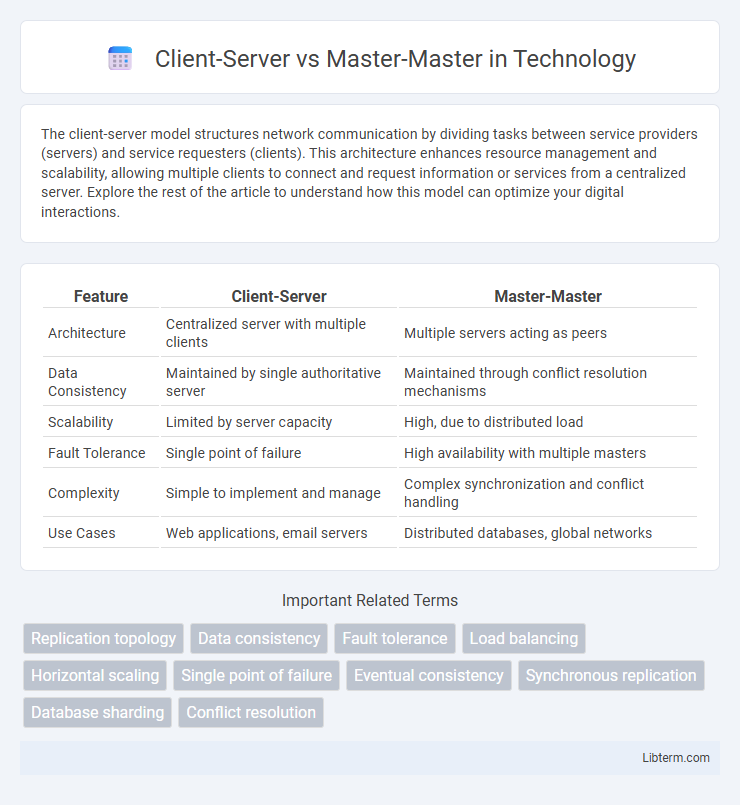The client-server model structures network communication by dividing tasks between service providers (servers) and service requesters (clients). This architecture enhances resource management and scalability, allowing multiple clients to connect and request information or services from a centralized server. Explore the rest of the article to understand how this model can optimize your digital interactions.
Table of Comparison
| Feature | Client-Server | Master-Master |
|---|---|---|
| Architecture | Centralized server with multiple clients | Multiple servers acting as peers |
| Data Consistency | Maintained by single authoritative server | Maintained through conflict resolution mechanisms |
| Scalability | Limited by server capacity | High, due to distributed load |
| Fault Tolerance | Single point of failure | High availability with multiple masters |
| Complexity | Simple to implement and manage | Complex synchronization and conflict handling |
| Use Cases | Web applications, email servers | Distributed databases, global networks |
Introduction to Client-Server and Master-Master Architectures
Client-Server architecture centralizes processing by designating specific servers to handle client requests, improving control and security in applications like databases and web services. In contrast, Master-Master architecture enables multiple nodes to act as masters simultaneously, facilitating high availability and load balancing through data replication and conflict resolution mechanisms. Understanding these foundational architectures is crucial for optimizing network performance and scalability in distributed systems.
Core Principles of Client-Server Systems
Client-server systems operate on a clear division of roles, where clients request services and servers provide resources, ensuring centralized control and resource management. This architecture supports scalability and security by allowing servers to handle multiple client requests while maintaining data integrity and access control. In contrast, master-master replication involves multiple nodes with equal authority, designed for high availability and fault tolerance but requiring complex conflict resolution mechanisms.
Core Principles of Master-Master Systems
Master-Master systems rely on bidirectional replication where each node can act as both client and server, ensuring high availability and fault tolerance by allowing multiple servers to process requests and update data simultaneously. Conflict resolution mechanisms like version vectors or timestamps are essential to maintain data consistency across all nodes in the network. These systems emphasize decentralization, scalability, and seamless synchronization, contrasting with the traditional Client-Server model where a single server manages requests from multiple clients.
Data Consistency and Synchronization
Client-Server architecture centralizes data management, ensuring strong consistency through a single authoritative source, which simplifies synchronization but may incur latency and bottlenecks. Master-Master replication distributes data across multiple nodes that simultaneously handle updates, enhancing availability and fault tolerance but requiring complex conflict resolution strategies to maintain eventual consistency. Effective synchronization in Master-Master systems depends on mechanisms such as version vectors or timestamp ordering to detect conflicts and reconcile divergent data states.
Scalability and Performance Comparison
Client-Server architecture centralizes data processing, which can limit scalability due to a single server bottleneck, but offers consistent data integrity and simplified management. Master-Master replication enables high scalability by distributing read and write operations across multiple nodes, enhancing performance through load balancing and fault tolerance. However, this model requires complex conflict resolution mechanisms to maintain data consistency during concurrent updates.
Fault Tolerance and High Availability
Client-Server architecture offers moderate fault tolerance by centralizing control on a single server, which can become a single point of failure, whereas Master-Master replication enhances fault tolerance through multiple active nodes that synchronize data continuously. High availability is typically limited in Client-Server models due to server dependency, while Master-Master architectures provide superior uptime by enabling automatic failover and load balancing across redundant servers. These features make Master-Master replication ideal for systems requiring continuous data consistency and minimal downtime.
Use Cases: When to Choose Client-Server
Client-server architecture is ideal for scenarios requiring centralized control, such as enterprise applications, banking systems, and content management where data consistency and security are crucial. It suits workloads with a clear hierarchy, enabling efficient resource management and simplified maintenance by routing all requests through a single authoritative server. Use client-server models when you need strong consistency, simplified troubleshooting, and centralized data integrity over distributed concurrency.
Use Cases: When to Choose Master-Master
Master-Master replication is ideal for distributed systems requiring high availability, fault tolerance, and real-time data synchronization across multiple nodes, such as global e-commerce platforms and financial services. It ensures seamless write operations from multiple locations, reducing latency and eliminating single points of failure compared to Client-Server architecture. Organizations benefit from Master-Master setups when consistent, multi-site data updates and load balancing are critical for business continuity.
Security Considerations in Both Architectures
Client-server architecture centralizes data control, allowing for robust security measures such as centralized authentication, access controls, and easier monitoring of data flow, which reduces the risk of unauthorized access. Master-master replication distributes data control across multiple nodes, increasing the complexity of securing synchronization and conflict resolution processes while requiring stringent encryption and consistency checks to prevent data breaches. Both architectures demand comprehensive security protocols, but master-master systems necessitate advanced strategies to protect data integrity across multiple active nodes.
Future Trends in Distributed System Architectures
Future trends in distributed system architectures emphasize enhanced scalability and fault tolerance, with Client-Server models evolving to support edge computing and real-time data processing. Master-Master configurations gain prominence through improved conflict resolution algorithms and blockchain integration, enabling decentralized control and high availability. Emerging technologies such as AI-driven orchestration and hybrid multi-cloud deployments further drive innovation in these architectures.
Client-Server Infographic

 libterm.com
libterm.com